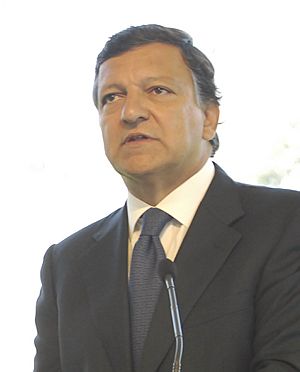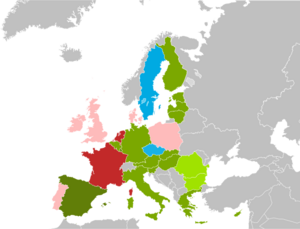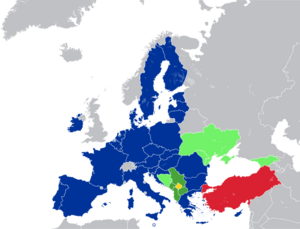History of the European Union (2004–present) facts for kids
The history of the European Union from 2004 until today is a time of big changes and new rules for the European Union. After 2004, the EU welcomed ten new countries, and then two more in 2007. Many of these new members were not as rich as the older EU countries.
Around this time, the EU also created the euro currency and expanded the Schengen Area, which allows people to travel freely between many EU countries without border checks. However, this period also saw a major economic crisis and disagreements over new rules like the European Constitution and the Treaty of Lisbon. Throughout these years, the European People's Party has been the largest group in the European Parliament and has provided every President of the European Commission.
Contents
EU Leaders and Parliament
From June 10 to 13, 2004, 25 EU countries held the biggest international election ever. People voted for members of the European Parliament. The election was won by the European People's Party-European Democrats group. However, fewer people voted than ever before, with only 45.5% of eligible voters participating.
Choosing the Commission President
The Prodi Commission was ending its term in October 2004. So, after the elections, leaders looked for a new Commission President. Some countries wanted Guy Verhofstadt, the Prime Minister of Belgium. But others, like the UK and Poland, didn't agree with him on the Iraq War.
Many other important people were considered for the job. These included Jean-Claude Juncker from Luxembourg and Bertie Ahern from Ireland. In the end, José Manuel Barroso from Portugal became the leading choice. He was approved by the Parliament on July 22, 2004.
New Commissioners Face Challenges
When Barroso chose his team of Commissioners, some members of the Parliament had concerns. They questioned a few candidates, especially Rocco Buttiglione. He was meant to be the Commissioner for Justice, Freedom, and Security. However, some of his past comments on women and homosexuality made MEPs worry if he was suitable for a job protecting civil rights.
The Socialists strongly opposed Barroso's team. The People's Party supported it. The Liberals were split. The Socialists said they would vote against the whole team if Buttiglione stayed. This meant the Barroso Commission might be the first ever to be rejected by Parliament.
Barroso eventually changed his proposed team. Buttiglione was replaced by Franco Frattini. Two other candidates were also changed. The new team was approved on November 18, 2004, and they started work on November 22.
New Members, New Commissioners (2007)
On January 1, 2007, Bulgaria and Romania joined the EU. Each country got to choose one new Commissioner. This made the total number of Commissioners 27.
Bulgaria chose Meglena Kuneva for the Consumer Protection job. Parliament liked her and approved her easily. Romania first suggested Varujan Vosganian, but he was not approved due to his views and lack of EU experience. Romania then proposed Leonard Orban. He became the Commissioner for Multilingualism. Parliament approved him too.
Barroso's Second Term (2009)
The 2009 elections again saw the European People's Party win the most seats. Jerzy Buzek became the first President of the European Parliament from an Eastern European country.
In 2008, leaders began supporting Barroso for a second term as Commission President. He officially announced he wanted to continue in July 2008. Even though the People's Party won the most seats, they didn't have enough to approve Barroso alone. The Socialists and Liberals tried to get Barroso to agree to their ideas before they would support him.
Barroso met with different political groups in September 2009. He explained his plans for his next term. The People's Party and some conservative groups supported him. The Socialists and Greens did not. However, MEPs vote in secret, so it's hard to know exactly how everyone will vote. On September 16, 2009, Barroso was re-elected by Parliament.
Bulgaria's first choice for Commissioner, Rumiana Jeleva, had to step down. This was because MEPs questioned her suitability. Bulgaria quickly chose Kristalina Georgieva instead. This delayed the vote on the whole Commission team. The new team was finally approved on February 9, 2010.
Changing EU Rules
The European Constitution Idea
In 2003, the Treaty of Nice came into effect. It helped the EU prepare for new countries joining in 2004. But some people thought more changes were needed. So, a group led by former French president Valéry Giscard d'Estaing started to write a European Constitution. This Constitution aimed to combine all existing EU agreements into one simpler document. The final text was agreed upon in June 2004 and signed in Rome in October 2004.
The Constitution suggested several changes. More decisions would be made by majority vote, and the Parliament would have more say. It also aimed to simplify the EU's structure. For example, it proposed a permanent President of the European Council instead of having the role rotate. It also wanted to combine the High Representative and the European Commissioner for External Relations roles to create one strong diplomatic voice for the EU.
When Countries Said "No"
Each EU country had to approve the Constitution for it to become law. Most countries approved it through a vote in their Parliament. But some countries held a public vote, called a referendum. Spain was the first to hold a referendum and approved it.
However, on May 29, 2005, the people of France rejected the Constitution. Just three days later, the Netherlands also rejected it. These rejections from important EU countries caused a big problem. Many other countries then cancelled their planned referendums.
After these rejections, EU leaders took a "period of reflection" to decide what to do. This period ended with the Berlin Declaration in 2007. This declaration aimed to find a new way forward. A group called the Amato Group suggested writing a new treaty. This new treaty would change existing EU agreements and make the Charter of Fundamental Rights of the European Union legally binding.
The Lisbon Treaty
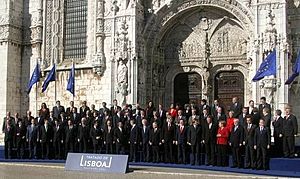
Leaders agreed on a plan for a new treaty. They decided to remove much of the "Constitution" language and symbols. This new treaty was called the "Reform Treaty," and later the Treaty of Lisbon. It aimed to make many of the same changes as the Constitution but in a different way. It would amend existing treaties rather than create one new document.
The Treaty of Lisbon was signed in Lisbon, Portugal, on December 13, 2007. It was designed so that most countries would not need to hold a referendum. However, Ireland's constitution required a public vote. In 2008, Ireland voted against the treaty. But after some guarantees were given to Ireland, they voted again in 2009 and approved it.
The Lisbon Treaty finally became law on December 1, 2009. It created the new job of President of the European Council, which went to Herman Van Rompuy. It also greatly expanded the role of the High Representative, with Catherine Ashton taking that position. The treaty also gave the European Parliament more power in some areas.
Changes in EU Membership
More Countries Join the EU
On January 1, 2007, Bulgaria and Romania officially joined the EU. This was called the "fifth enlargement." Then, Croatia joined the EU as the 28th member on July 1, 2013. This was the "sixth enlargement."
Countries That Might Join Next
After a financial crisis, Iceland applied to join the EU. Negotiations were expected to be quick, but a new government in Iceland paused them.
There are also several other countries that are candidates or potential candidates to join the EU. These include Albania, Bosnia and Herzegovina, Georgia, Moldova, North Macedonia, Montenegro, Serbia, Turkey, and Ukraine. Kosovo is also part of the EU's enlargement plans.
Brexit: The UK Leaves the EU
On February 1, 2020, the United Kingdom officially left the European Union. This happened according to Article 50 of the Treaty on European Union, which allows a country to leave. After leaving, there was a transition period until December 31, 2020. During this time, the UK and EU worked out a new free trade agreement. The EU–UK Trade and Cooperation Agreement then started to apply.
The Euro and Economic Challenges
More countries adopted the euro currency after 2004. Slovenia joined the eurozone in 2007, Malta and Cyprus in 2008, Slovakia in 2009, Estonia in 2011, Latvia in 2014, Lithuania in 2015, and Croatia in 2023.
However, in 2008, the eurozone faced its first economic recession. EU countries worked together, and the European Central Bank helped to improve the economy. The euro was seen as a safe currency during this time.
Later, in 2009-2010, there was a risk that Greece and other countries might not be able to pay their debts. This was a big problem for the euro. EU treaties usually say that countries should not bail out other euro members. But because of the serious risk to the whole eurozone economy, leaders agreed to create a way to help countries that were struggling financially. This crisis also led to ideas for closer economic cooperation within the EU.
Migrant Crisis
Around 2015, the EU faced a major migrant crisis. Many people from outside the EU sought safety and new homes in Europe. This led to challenges and discussions about how to manage the large number of arrivals.
Impact of the COVID-19 Pandemic
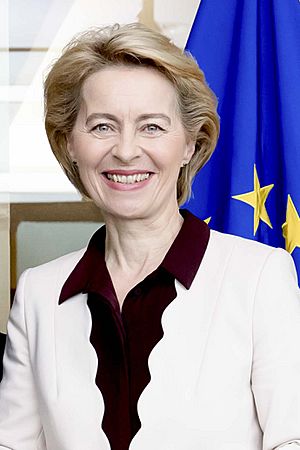
After the COVID-19 pandemic caused a big economic crisis, EU leaders did something new. For the first time, they agreed to borrow money together. This money was used to fund a special European Recovery Program called Next Generation EU (NGEU). It aimed to help EU countries recover from the economic effects of the pandemic.
Impact of the Russo-Ukrainian War
On February 24, 2022, Russian Armed Forces launched a full-scale invasion of Ukraine. This war had a big impact on the EU.
The European Union quickly put strong sanctions on Russia. They also agreed to provide military aid to Ukraine. Many Ukrainian refugees fled the conflict and came to neighboring EU countries. The war also showed how much the EU relied on Russia for energy. This made the EU want to find new energy suppliers and develop more clean energy sources.
See also


